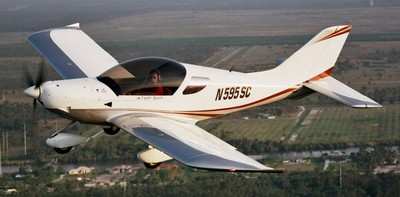Flight Instructor Reported To The Controller "We Are Having Some Power Loss"
Location: Van Nuys, CA Accident Number: WPR23FA299
Date & Time: August 2, 2023, 10:36 Local Registration: N384SC
Aircraft: Czech Sport Aircraft SportCruiser Injuries: 2 Fatal
Flight Conducted Under: Part 91: General aviation - Instructional

On August 02, 2023, about 1036 Pacific daylight time, a Czech Sport Aircraft SportCuiser (file photo, below), N384SC, was destroyed when it was involved in an accident in Van Nuys, California. The flight instructor and student pilot were fatally injured. The airplane was operated as a Title 14 Code of Federal Regulations (CFR) Part 91 instructional flight.
A review of Automatic Dependent Surveillance – Broadcast (ADS-B) flight tracking data revealed that the airplane initially departed runway 16L about 1021:33. The airplane made a left traffic-pattern and performed a touch-and-go practice landing and takeoff at 1027:39. The airplane made another left traffic pattern following a similar flight path as the first path. The airplane touched down about 1033:57 and then became airborne about 1,700 ft down the runway, in nearly the same place as the previous takeoff. Thereafter there is a gap in data for about 14 seconds and the next hit reappears at taxiway “K,” with a groundspeed reduction from 60 to 50 kts. The flight path continued at that speed and the altitude increased.
At 1035:09, the airplane made a left turn onto the crosswind leg of the traffic pattern while climbing to an altitude of approximately 315 ft above ground level (agl). The airplane then transitioned to the downwind leg. A data gap of 15 seconds ensued until the airplane’s track reappeared at 1035:42, where the data showed a speed of 71 knots while flying at an altitude of 430 feet agl; this marked the highest altitude attained during this flight segment. The airplane veered left towards the airport while the altitude gradually decreased. At around 1036:12, when positioned about 830 ft from the runway, the aircraft made a slight right turn to parallel runway. About 22 seconds later, as the airplane reached a point abeam the runway numbers of 16L, it was traveling at an groundspeed of about 55 kts. The airplane then turned left while at an altitude about 195 ft agl. The last hit was at 1036:39 and located 255 ft eastnortheast of the accident site; it showed an altitude of 170 ft agl.
Numerous security cameras captured footage of the airplane's movements leading up to the impact. After the airplane turned onto the downwind leg of the traffic pattern for runway 16L, it maintained a steady altitude. Around 1035:42, the airplane performed a complete 360° turn, during which it experienced fluctuations in altitude. Towards the end of the turn, the airplane climbed in altitude. The airplane briefly flew towards the runway, descending in altitude, before readjusting to fly parallel to the runway.
At 1036:35, the airplane initiated a left bank, aggressively increasing the steepness of the bank. As the bank angle intensified, the nose of the airplane dropped lower. The airplane impacted in a near vertical attitude; there was no parachute deployed and the flaps appeared to be retracted.
The pilot was in communication with Van Nuys Air Traffic Control during the flight. The times the audio transmissions were made could not immediately be verified. The student pilot was making the transmissions for the beginning portion of the flight. On the third takeoff, the flight instructor reported to the controller “we are having some power loss.” The controller asked if they required assistance. The instructor stated, “priority landing,” which he repeated several times because the controller could presumably could not understand the communications.

Approximately 30 seconds following the transmission indicating a "power loss," the controller issued a clearance for the airplane to land on runway 34R. This runway corresponds to the departure runway, albeit in the opposite direction. The controller asked again if the pilot required assistance and the instructor replied “negative, we are landing right now.” Approximately one minute following the transmission indicating a "power loss," the controller issued a clearance that the airplane could land on any runway. About 10 seconds later, the controller asked what the nature of their emergency, to which the instructor responded, “we are having exhaust gas temperature issues.”
The accident site was located on a helicopter parking ramp about 425 ft from the edge of runway 16L. The wreckage was found all within the same vicinity on a heading of 300°. The furthest wreckage was part of the rocket from the Ballistic Recovery System (BRS) system; the rocket had been deployed and was found immediate ahead of the wreckage along with small plexiglass shards in front of the main wreckage. A majority of the wreckage was consumed by fire.
The wreckage was recovered to a secure location for further examination.
 ANN's Daily Aero-Term (05.10.24): Takeoff Roll
ANN's Daily Aero-Term (05.10.24): Takeoff Roll Aero-News: Quote of the Day (05.10.24)
Aero-News: Quote of the Day (05.10.24) Aero-News: Quote of the Day (05.11.24)
Aero-News: Quote of the Day (05.11.24) ANN's Daily Aero-Term (05.11.24): IDENT Feature
ANN's Daily Aero-Term (05.11.24): IDENT Feature ANN's Daily Aero-Linx (05.11.24)
ANN's Daily Aero-Linx (05.11.24)




